Abstract
Landscape permanence is understood as the temporal extent of the dominance of a given type of landscape, expressed by the temporal continuity of its use. This issue, already being the subject of much research, is important in proper landscape protection and management. In this paper, spatial landscape persistence and persistence of particular landscape types are presented for the Ogrodzieniec municipality, Częstochowa Upland, Poland. In addition, a background of landscape types and their changes in the Częstochowa Upland has been presented. Based on current and historical topographic maps, landscape types (forest, agriculture, settlement, fortified and industrial) were identified for the following studied periods: 1831, 1944, 1965, 2007, 2014 and 2020. After overlapping the maps, the persistence index was calculated, and isochrones of landscape persistence were determined. The term ‘landscape isochrones’ introduced in this paper is defined as theoretical lines of equal landscape time duration (iso-persistence line). The results show that the landscape of Ogrodzieniec can be considered to be persistent. The largest area of the municipality is occupied by the most permanent landscapes dating from before 1831. The most persistent is the fortified landscape. The method applied is important for planning sustainable development of the region, which is currently under intense tourist and economic pressure.
1. Introduction
The permanent process of evolution in nature leads to a diversification of the world’s landscapes, which are dynamic, thus demonstrating the continuous activity of our planet [1]. Cultural landscapes, developed on the base of natural landscapes over the past 10,000 years, were formed by natural factors but were (and still are) additionally modified by many non-natural factors—social, psychological, economic, religious, historical-cultural, political, legal-administrative, technological [2]. Their impact, scale, intensity, and scope vary and depend on the stage of cultural development of societies and the current predominant land use. If a specific kind of balance is established between these factors and the style of land use, then the cultural landscape becomes temporarily ‘preserved’—consolidated.
Cultural landscape, as well as natural landscape, is an evolving typological concept [3,4,5]. It is assumed that it has developed based on the natural landscape, and its structure depends significantly on the functions that man has designated for a particular area. These in turn are highly dependent on the resources of the natural environment and the social capital. This approach considers the genesis and historical development of areas with all the factors that determine the process of how cultural landscapes are formed. Therefore, for the presented concept, a definition of cultural landscape has been adopted which is understood as a historically formed fragment of geographical space created as the result of a combination of environmental and cultural factors, forming a specific structure reflected by regional distinctiveness perceived as a specific physiognomy [6]. The temporal extent of the dominance of a given type of landscape expressed by the temporal continuity of its use (time depth) is evidence of landscape permanence. Sustainability is one of the most important parameters of landscape stability [7]. Stability is usually studied from an ecological perspective (among others [8,9,10,11]). Grimm and Wissel [12] distinguish three stability properties: constancy (staying essentially unchanged), persistence (persistence through time), and resilience (the return to a reference state after a temporary disturbance). According to Peng et al. [10], stability is the characteristic of land use and durability of ecological processes reflecting the relation between regional land use patterns and environmental conditions. Landscape persistence can be understood as the persistence of particular land cover classes measured as the percentage of the area where land use has not changed over a specified period [13]. Many methods and sources of cartographic analysis enable an approximate assessment of the persistence of cultural landscapes (e.g., [14,15,16]). This concept has already been the subject of research (e.g., in mountain areas) conducted by M. Sobala [7] (Beskids), J. Godziek and B. Szypuła [17] (Bekids and Gorce), J. Wolski [18] (Bieszczady), A. Affek [13] (Eastern and Western Carpathians), and I. Pǎtru-Stupariu et al. [19] (Romania’s Carpathian). In this paper, the spatial aspects of the landscape persistence issue were applied to a very characteristic area of the Częstochowa Upland (southern Poland) in the Ogrodzieniec municipality (located on the western edge of the Częstochowa Upland). This is an area with high natural and cultural values exposed to strong settlement and tourist pressures, which are reflected in changes in the landscape. The following questions guided this landscape study: is Ogrodzieniec a typical representation in terms of the landscape of the Częstochowa Upland? What parts of Ogrodzieniec are the most persistent? What type of landscape is the most persistent?
The research task was to assess the landscape structure of the Ogrodzieniec municipality against the backdrop of the Częstochowa Upland and, on this basis, to determine the persistence of this landscape. The objectives of this paper were:
- (a)
- to determine landscape persistence by defining the continuity of a given type of landscape of Ogrodzieniec using the persistence index,
- (b)
- to determine the spatial range of the landscape persistence of Ogrodzieniec,
- (c)
- to define and introduce into the literature the concept of isochrones of landscape persistence,
- (d)
- to analyze the evolution of the cultural landscape of a selected settlement unit (Ogrodzieniec municipality) and its current structure against the backdrop of the landscape of the whole geographical region.
Based on an analysis of historical and contemporary topographic maps, landscape overlays were interpreted. Interpretation made it possible to recognize the stages of landscape development over the past 200 years (which was considered reliable in terms of the scientific sources obtained) and to assess the persistence of particular types of land use (the time depth of landscape types).
2. Materials and Methods
The research was carried out for the Ogrodzieniec municipality. To show the background (context) of the landscape structure of Ogrodzieniec, analysis of the Częstochowa Upland was carried out. The research algorithm is presented in Figure 1.
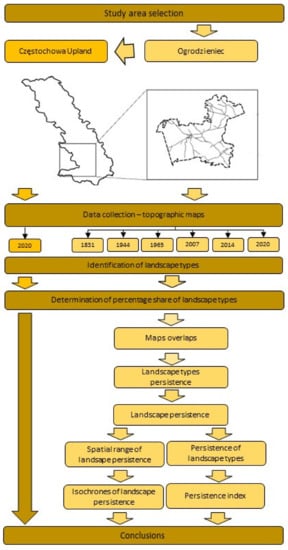
Figure 1.
The research methodological framework to assess the landscape persistence of Czestochowa Upland and Ogrodzieniec, Poland.
2.1. Study Area
The mesoregion of the Częstochowa Upland (Poland) was adopted as a background for analysis of the landscape structure. The area covers 982.95 km2, and the perimeter is 245.79 km [20] (Figure 2). This area has a long and diverse history of evolution of the natural environment and a long history of anthropogenic land use. Recent studies of Poland’s physico-geographical regionalization [20] assigned the study area to a part of the macroregion of the Krakow–Częstochowa Upland. Administratively, the research area is mostly located within the Silesian Voivodship and its southern part in the Małopolskie Voivodships.
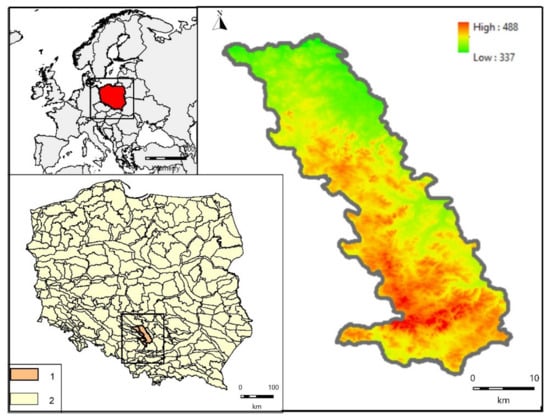
Figure 2.
Localization of the Częstochowa Upland against the background of Europe (left top) and Poland (left bottom) and a terrain model of Częstochowa Upland (right). 1—Częstochowa Upland, 2—mesoregions of Poland.
The Upland is formed by limestone and characterized by Upper Jurassic (oxfords), slabby, rocky and oolitic soils, and also by marls. On the western side, the Częstochowa Upland is bounded by a steep slope of the Upper Jurassic cuesta, which is clearly visible in the landscape, locally reaching a relative height of 70–100 m. From the north, the upland is enclosed by the gorge section of the Varta river on the east of Częstochowa (gorge of the Varta river in Mstów). The highest areas, often exceeding a height of 450 m, are located in the central part of the Upland [21,22].
The area of the research—the Ogrodzieniec municipality—is located in two mesoregions: the Częstochowa Upland and the Siewierz Basin [20] (Figure 3). The area of the municipality is 86 km2. According to a historical–cultural regionalization of contemporary Poland, the Ogrodzieniec municipality is located in Province II, Land A (indigenous Polish lands, central and eastern region, former Russian partition), but is divided into different historical and cultural regions: II.A.25 (Jura Krakowsko–Częstochowska, central and southern part) and II.A.27 (Nida and Pinczow Lands) [23]. The municipality is located within a legally protected area, the Eagles’ Nests Landscape Park.
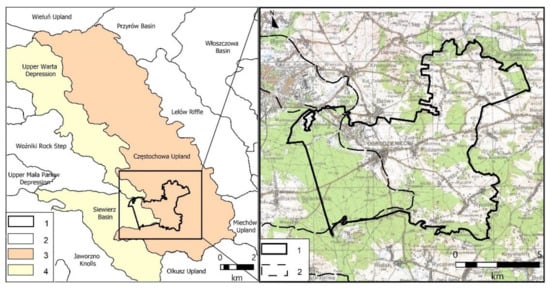
Figure 3.
Location of the Ogrodzieniec municipality against the Częstochowa Upland background (left) and topographic map of Ogrodzieniec divided into two mesoregions (right). 1—Study area and administrative borders of Ogrodzieniec municipality, 2—Mesoregions borders, 3—Częstochowa Upland, 4—Siewierz Basin.
The area of the Ogrodzieniec municipality belongs geologically to the Silesian–Cracow Monocline, which is formed by carbonate Triassic and Jurassic formations locally covered by quaternary formations. A characteristic element of the landscape (a landmark) is the highest elevation of the Upland, Janowski Mountain (516 m a.s.l.), with the ruins of a castle and a group of rocks, the so-called ‘rock city’, where four groups of rocks in the form of pillars, towers, and maces appear.
The river network of the municipality is a system of the Czarna Przemsza and Ogrodzieniecki Stream. The dominant soils in the study area are podsolic or pseudopodsolic soils and brown rendzina, black earths, and rendzina with a poorly developed profile. The strong diversity of the relief (including large denivelations) and different types of soils have contributed to the diversity of the municipality’s flora. The forest communities are dominated by pine forests, but the characteristic communities of Ogrodzieniec are the Sudeten Mountain Beech Forest and the Lowland Beech Forest. On the limestone hills and rocks, which are not covered by forest, calcareous and thermophilous rock grasslands and xerothermic grasslands have developed [24].
The settlement in Ogrodzieniec has pre-medieval origins. Archaeological excavations confirm that the settlement on the hill was already developing in the Iron Age. A more intensive development of settlement processes dates back to the 14th century, when, under Kazimierz the Great, the royal castle was built and a settlement around Birów Mountain was established. To the west of the castle, the Podzamcze rural complex was formed based on a former settlement functioning for the Ogrodzieniec castle’s needs. Currently, the settlement has an irregular multipath layout [25] and the built-up areas are expanding. Agriculture and forestry remain the typical forms of land use, but there has been a steady increase in contemporary developments for leisure and tourism, which have clearly modified the landscape structure in recent years. Temporary tourist facilities (car parks, amusement parks) and numerous single-family houses are being built, mainly in the southern part of the Podzamcze district.
The municipality also has a mining tradition. Limestone and marl for the cement industry were mined in Ogrodzieniec from the 1950s until 1998. The currently inactive quarry is located north of the town on the road to Zawiercie. Due to its scientific and educational value, it is considered to be a so-called geosite [26].
All of these complex processes and forms concentrated within one administrative unit were the reason why an in-depth analysis of landscape persistence was undertaken.
2.2. Materials
In the research, quantitative analyses were carried out using topographic maps from the past nearly two hundred years. The Database of Topographic Object (TBD) (2020) digital maps was used to compare the contemporary landscape of the Upland and Ogrodzieniec. Historical topographic maps, both digital (2014 TBD, 2007 V Map Level 2, 1:50,000) and digitized (1965, 1:50,000, 1944, 1:100,000, 1831, 1:126,000), were used to analyze changes in the landscape of Ogrodzieniec (Table 1). It should be noted that maps from different periods, in different cartographic representations and types of presentation (raster and digital maps: V Map, BDOT) differ in detail and accuracy. The choice of cartographic materials was dictated mainly by the accessibility of maps for a given area.

Table 1.
Sources and materials used in the cartographic research.
2.3. Methods
A quantitative analysis of the share of different landscape types (2020) using cartographic methods was performed using GIS software (Mapinfo Pro17), and statistical methods (calculation of the percentage). For the Częstochowa Upland, the map of contemporary (current) landscapes was determined from the TBD digital map (2020) and land cover layers, at level 2. Forest, agricultural, settlement, and industrial (including mining) landscapes (understood as forms of land cover, according to Chmielewski [27]) were identified. In addition, based on the range of contemporary forms of nature protection (reserves), the range of seminatural (preserved) landscapes was outlined. The seminatural landscapes of the landscape parks were not included due to the changes in the natural environment caused by settlement, agriculture, and tourism and also due to the different types of use occurring within them. Only a small area of the landscape parks has a quasi-cultural character. On the map, the tourist landscape type was intentionally omitted. However, practically the whole Upland is under increased tourist exploration due to its unique natural and cultural (landscape) values. However, intensified (specific for tourist services) tourist infrastructure has not been developed here yet (large-scale hotels appear singly in different parts of the Upland). This infrastructure is scattered and has no concentrated form yet—its origins are in the area of Złoty Potok, Olsztyn, Podlesice and Ogrodzieniec. Neither have religious landscapes been identified as a separate type, despite the fact that there is a supra-regional pilgrimage center at Leśniów which has been important since the 18th century. The Blessed Virgin Mary Sanctuary and functionally related facilities occupy a small area (approx. 20 ha) and therefore their impact on the landscape is minor and does not justify, on this scale of analysis, a separate delimitation of type.
For the area of the Ogrodzieniec municipality, research was carried out to determine the persistence of the landscape. For this purpose, maps from the years 1831, 1944, 1965, 2007, 2014, and 2020 were analyzed using digital layers (TBD digital map for 2014 and 2020—land cover layers at level 2 and V-Map, level 2 for 2007) and vectorizing data from raster maps (1831, 1944, 1965). Land cover was categorized into forest, agricultural, settlement, and industrial (including mining) landscapes. Due to the characteristics of the municipality, the fortified settlement landscape, which forms the core and the oldest element of the study area, was also distinguished. The presence of surface water was also taken into account, although due to the small size of the reservoirs they were not delineated as a separate landscape type.
After overlapping the layers of individual landscape types from successive years (Figure 4), the spatial range of landscape persistence and the persistence of individual landscape types were determined. The spatial range was presented by the authors’ proposed isochrones of landscape persistence, i.e., theoretical lines of equal landscape time duration (iso-persistence line). The isochrones were delimitated for each landscape type and, after overlapping the different types from each period, the persistence isochrones of the entire landscape of the municipality were delineated.
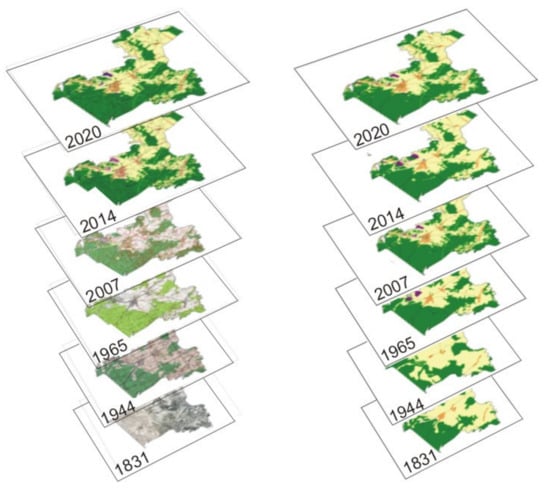
Figure 4.
Overlay of topographic maps of studied years (left) and of maps of landscape types (right) of the Ogrodzieniec municipality.
In the next step, the persistence of each landscape type was calculated using a persistence index PI [19], which is presented by the formula:
where Ui indicates the area (in km2) of the unchanged surface of landscape type i, which means that this area was of the same type of landscape as on the maps from 1831, 1944, 1965, 2007, 2014, and 2020. Hi indicates the coverage of the landscape of type i in 1831. The PI ranges from 0 to 1 (0 = very low persistence; 1 = very high persistence), which enables the results to be compared and the most persistent type of landscape to be indicated.
PIi = Ui/Hi,
3. Results
3.1. Current Landscape of the Częstochowa Upland
Quantitative cartographic analysis of the landscape types of the Częstochowa Upland area (Figure 5) shows a prevalence of agricultural landscapes (55.15%). Due to the migration of people to larger cities and the development of services, including tourism, cultivation is being abandoned [2]. A significant area is occupied by forest landscapes (29.20%). The detailed TBD map shows a significant mosaic of forest and agricultural landscapes in the northern and central parts of the area. The largest compact forest landscapes are present in the area of Olsztyn and Janów. The largest seminatural area under legal protection (reserves: Sokole Góry, Parkowe) also exists there. Settlement landscapes occupy a small area, 5.18%, although these areas are now increasing due to the development of services and tourism, including in particular the construction of second homes and summer homes.
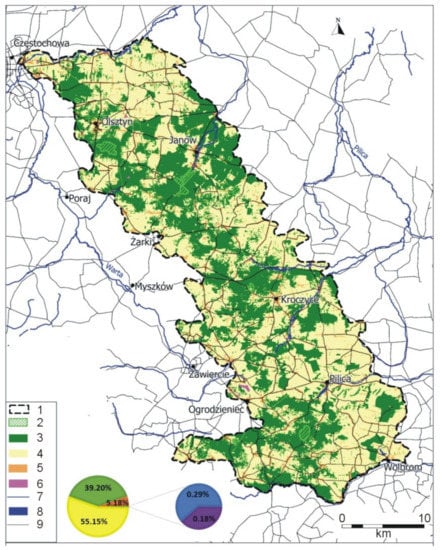
Figure 5.
Map of the current main types of cultural landscapes in the Czestochowa Upland. 1—Research area, 2—Protected landscapes (seminatural), 3—Forest landscapes, 4—Agricultural landscapes, 5—Settlement landscapes, 6—Industrial and mining landscapes, 7—Rivers, 8—Water reservoirs (bands of water-management landscapes), 9—Main roads.
3.2. Landscape Persistence of the Ogrodzieniec Municipality
In the studied period, within the Ogrodzieniec municipality, a systematic increase in settlement and forest landscapes was registered, which replaced agricultural landscapes (Figure 6, Table 2). In 1831 the agricultural landscape covered 66.16% of the municipality area, but in 2020 it was only 40.72%. The forest landscape area, on the other hand, changed from 32.65% in 1831 to 53.06% in 2020. The settlement landscape represents a small part of the municipality but is still growing. In the 1950s a new type of landscape appeared—the industrial (mining) one, in the northwestern part of the municipality. It is marked on the 1965 map. After years of development of this type of landscape, nowadays, this type of landscape is shrinking back again (from 0.86% in 1965, to 1.02% in 2007 and 0.67 in 2020).
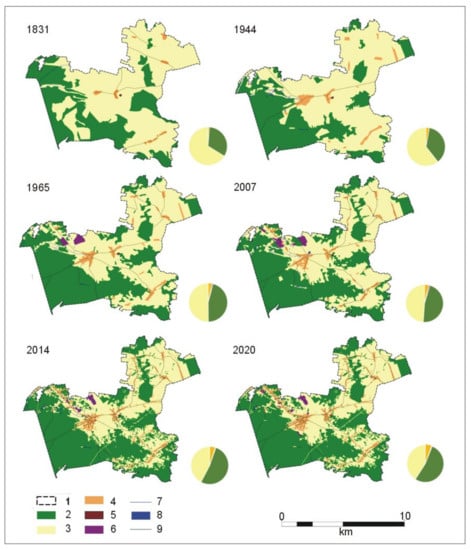
Figure 6.
Area changes of different landscape types in the Ogrodzieniec municipality in the years 1831–2020. 1—Municipality borders, 2—Forest landscape, 3—Agricultural landscape, 4—Settlement landscape, 5—Fortified landscape, 6—Industrial landscape, 7—Rivers, 8—Water reservoirs, 9—Roads.

Table 2.
Changes in the percentage share of different landscape types in the Ogrodzieniec municipality between 1831 and 2020.
Based on the presented changes of landscape share, the persistence isochrones of individual landscape types were determined. The most persistent landscape is the fortified one, which, as a historic cultural, preserved landscape, has not changed as a type from the 14th century to the present day. Agricultural landscapes are the next most persistent, with 74.38% occurring in the same areas from 1831 to 2020. The youngest landscape is the industrial one, which only began to form after 1944. Quite substantial areas of forest landscape have also remained unchanged since at least 1831, with 39.15% of woodland landscapes existing in 2020 dating back to the 19th century. The settlement landscape is characterized by a low level of persistence, with a systematically increasing area. The isochrones of persistence of individual landscapes are presented in Figure 7 and Table 3.
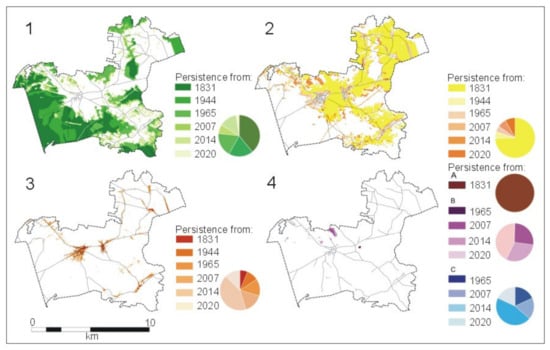
Figure 7.
Isochrones of landscape persistence for individual landscape types. 1—Forest, 2—Agricultural, 3—Settlement, 4A—Fortified, 4B—Industrial, 4C—Water reservoirs.

Table 3.
Persistence of individual landscape types—percentage share.
When calculating the persistence of landscape types using the persistence index, a slightly different result was obtained (Table 4). According to the index, the most persistent landscapes after fortified are forest ones. This result is related to the relatively small proportion of forest in 1831, and the significant increase in this area in subsequent years, so that most of the forest landscapes from 1831 were retained in 2020.

Table 4.
Persistence index.
In the next step, maps of persistence of particular landscape types were overlapped to obtain a map of persistence of the entire Ogrodzieniec landscape (Figure 8). In terms of spatial distribution, the most extensive areas with the most permanent landscapes are located in the southwestern and northeastern parts.
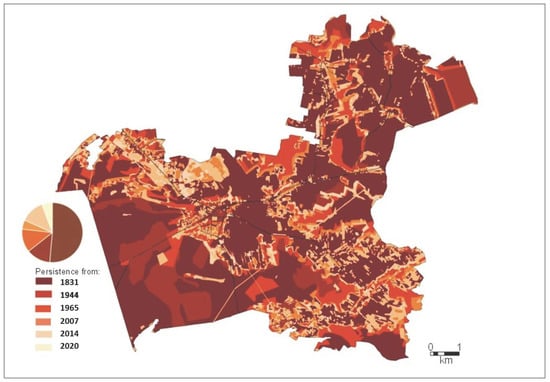
Figure 8.
Isochrones of landscape persistence of the Ogrodzieniec municipality.
In quantitative terms, the most persistent landscapes predominate (54.44%). They illustrate an unchanged land cover or land use for at least 190 years as they were developed before 1831 and lasted unchanged within the described boundaries until 2020 (Table 5). A similar permanence characterized Ogrodzieniec’s landscapes in later years, as documented by maps from 1944, 1965, and 2014. Small percentages are characteristic of the least persistent landscapes occurring as new types of land use on different land and illustrated only in maps from 2020 (5.91%) and 2007.

Table 5.
Landscape persistence of the Ogrodzieniec municipality.
4. Discussion
4.1. Comparison of the Changing Landscape Structure of the Ogrodzieniec Municipality and the Częstochowa Upland
The method of landscape persistence assessment presented in this paper enables analysis of landscape changes. In the studied period, within the Ogrodzieniec municipality, a systematic increase in settlement and forest landscapes was registered, which replaced agricultural landscapes. The largest changes in the area occurred between 1944 and 1965 and 2007–2014. During this time, there was the most significant increase in the area of forest landscapes and a decrease in the area of agricultural landscapes. The core of the landscape, unchanged since the 19th century, is the fortified landscape (castle). Its closest surroundings, on the other hand, changed considerably. Initially, the castle was surrounded by deforested areas, but from 1965, the forest area on the eastern, and also on the southern and northern sides, gradually increased, covering the castle walls more and more closely.
On the basis of the conducted research on the current landscape of the Częstochowa Upland and landscape transformations for Ogrodzieniec, as well as comparing the results with the research of Nita and Myga-Piątek [28] on forest transformation in the Upland, and Myga-Piątek’s [2] research on landscape changes in the Częstochowa Upland, some similarities and differences of landscape changes in the Upland and Ogrodzieniec can be highlighted (Table 6). At the turn of the 19th and 20th centuries, both in the area of the Upland and Ogrodzieniec, the phenomenon of the concentration of settlements intensified, and there was an increase in forest areas in both Ogrodzieniec and the entire Upland. According to the map of 1831, forest areas then covered 21% of the Upland and 32.65% of Ogrodzieniec. Around the 1930–1940s, the forest area was already 24% in the Upland and 36.68% in Ogrodzieniec. In the subsequent years, there was a further considerable increase in forest landscapes and a simultaneous decrease in the area of agricultural landscapes. In the 1960s the forest cover for the Upland was 28% [28] and for Ogrodzieniec, 46%. The 1970s and 1980s were a time of intensive migration of people from rural areas to industrialized Częstochowa and the cities of the Upper Silesian conurbation, resulting in the abandonment of agricultural land use and a decrease in the settlement landscape area (from 4.18% in 1936 to 3.79% in 1984). The obvious consequence of this process was succession, mainly of black pine and Scots pine, to an open agricultural landscape. In addition, this process was intensified in the 1980s and 1990s, when intensive action to preserve nature and landscape (understood de facto as forest protection) began. The increase in forest and decrease of agricultural landscape was remarkable at the beginning of the 21st century, both in the entire Upland area and the Ogrodzieniec municipality. The reason was connected with several causes. First, a further abandonment of agriculture in favor of services and the selling off of plots of land for holiday homes was observed [28]. In the entire Upland, the soils are mostly poor, and the cultivation there is unprofitable. The abandonment of agriculture and grazing caused, in many places, natural succession (Figure 9). At the same time, in accordance with the 1997 National Forestry Policy and the Rural Development Program for 2007–2013 and 2014–2020, there has been an increased awareness of the need for afforestation, including on private, formerly arable lands. Many farmers have benefited from support for afforestation [29]. At the turn of the first and second decades of the 21st century, the possibility of farmers receiving direct payments for agricultural production led to the fact that allocating some agricultural land for afforestation lost its attractiveness. This policy change is reflected in reducing the dynamics of forest area growth for Ogrodzieniec: the increase in the period 2007–2014 was 5.95 percentage points, and in the period 2014–2020, only 0.7 points.

Table 6.
Landscape changes in Częstochowa Upland and Ogrodzieniec expressed as a percentage of individual landscape types. 1–Ogrodzieniec, 2–Częstochowa Upland.
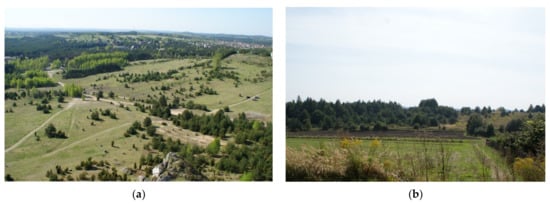
Figure 9.
Process of natural succession of abandoned arable fields and pastures in the area of Częstochowa Upland: (a) representative example for Częstochowa Upland–Olsztyn; (b) Ogrodzieniec.
Currently, in 2020, Ogrodzieniec’s landscape structure does not differ much from that of the Częstochowa Upland. The share of settlement and industrial landscapes is slightly higher. Differences occur mainly in the ratio of agricultural to forest landscapes; while in the entire area of the Upland agricultural landscapes dominate (55.15%), in Ogrodzieniec the dominant landscape is the forest one (53.06%). Settlement landscapes occupied a smaller area in Ogrodzieniec than in the Upland in the 19th and 20th centuries. Due to an increase in the attractiveness of settlements (related to both natural and landscape values and at the same time to the proximity to large cities [25]), there was an increase in the share of these landscapes in Ogrodzieniec in the 21st century and currently they occupy a larger area than in the Upland.
4.2. The Persistence of the Ogrodzieniec Landscape
The persistence index indicates that the most persistent landscape, except for fortified, is the forest landscape. This type was also identified as the most persistent by Affek in the Wiar catchment in the Polish Carpathians [13]. Other results using the same persistence index as in this paper have been obtained in The Bran-Rucăr Passageway in the Transylvanian Alps [19], where the most persistent landscapes were pasture ones.
The spatial distribution of landscape persistence isochrones is significant. Although the fortified landscape is the most persistent one, the surrounding landscape is very differentiated in terms of persistence. The closest area to the castle was pasture in the 19th century. Over the years, abandonment of grazing has resulted in the area becoming overgrown with forest (Figure 10). This transformation is also related to the development of residential areas and the development of tourism services, including tourism infrastructure. On the west side of the castle hill, there are currently a number of tourist facilities located in the viewing foreground of the castle (their nature is not permanent, but rather seasonal and therefore, they are not identified as separate tourist landscapes).
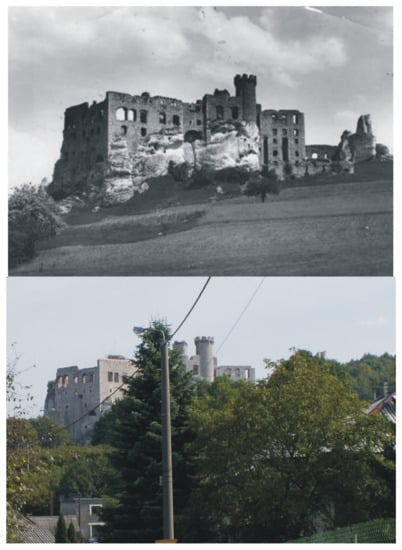
Figure 10.
Growth of forest areas and settlements in the vicinity of the castle ruins in Ogrodzieniec. At the top, a photo from the period 1918–1939 (photo from the National Digital Archive collection), at the bottom, a photo from 2020 (author’s own collection).
The largest compact areas of the most persistent landscapes are associated with the agricultural landscape in the northeastern and central parts, and the forest landscape in the western part of the municipality. The youngest landscapes are the industrial and post-industrial landscapes in the northwestern part. Other young landscapes are strongly fragmented, mainly due to the development of settlements and the afforestation of individual areas of farmland.
The developed persistence isochrones allow the determination and spatial visualization of landscape persistence in the studied areas. Determining the spatial range of landscape persistence, i.e., delineating the location and areas of the oldest landscapes, is important for proper cultural landscape planning, as well as integrating history and landscape processes [19]. The field observations and the wider context of the research suggest that landscape persistence should be considered one of the fundamental values of space. In the present times, which are characterized by very rapid spatial changes, e.g., in the field of land use (e.g., urban sprawl, suburbanization–peri-urban development, abandonment of agricultural land as economically unprofitable), the developed persistence index and isochrones inform about the degree of naturalness but also about the long-term adjustment (compatibility) of the land cover with the habitat conditions (rock substrate, soil quality, topography, water and topoclimatic conditions). For natural landscapes, it may be an important indicator that can be used for selecting areas of particular ecological protection. For cultural landscapes, e.g., rural ones, permanence informs about the tradition of the landscape and continuation of settlement functions. Such landscapes should also be indicated as areas of special values and included in forms of cultural protection (in Poland, e.g., cultural park, provisions in local spatial development plans). Maintenance of natural land cover or traditional land use contributes to biodiversity, including landscape diversity. Therefore, biodiversity conservation should take into account the issue of landscape persistence [30].
The presented method of identifying landscapes with the highest persistence may be helpful in the process of planning and spatial management at the local level (municipalities). It can also contribute to the identification of the so-called priority landscapes, which were introduced in Poland by the Act of 24 April 2015 amending some acts in connection with the strengthening of landscape protection tools [31], which is the result of the ratification by Poland of the European Landscape Convention [32].
Thus, the postulated landscape isochrones should be taken into account to verify (change) the range of today’s protected landscapes (landscape parks, reserves, protected landscape areas, Natura 2000)—selected on the basis of other, e.g., ecological criteria. Therefore, the presented method is universally applicable and complementary to the existing valorization methods and may also justify the need for landscape protection (e.g., designation of their most persistent and intact ‘core’) in the planning procedures.
However, the demand to maintain ‘old’ landscapes should not mean that the primary landscapes should be restored in the entire area. Diversity resulting from the changing land use is reflected in a positive phenomenon of the increasing complexity of the different ecosystems and increasing biodiversity. This process is evident in the case of xerothermic grasslands in the Upland, which were created as a result of grazing before the 20th century. In the second half of the 20th century, the grasslands underwent natural succession due to the abandonment of grazing, and in the past decades, the grasslands have been restored (e.g., within the framework of the Sheep Plus program [33] according to which grazing is restored to protect the grasslands). This is also a case of the vicinity of the castle. In a document: “Study of conditions and directions for spatial development [34]”, the forests surrounding the castle are indicated to be removed due to the lack of historic character.
On the other hand, modern land use associated with the development of buildings and the replacement of natural land cover, on a global scale, implies fragmentation of habitats and an increase in the mosaicism of the landscape, resulting in spatial chaos. Land use changes are widely studied also as a concept of land consumption [35,36]. The isochrones indicating the spatial range of landscape persistence and persistence index can show the scale of “land take”. [36] In the case of Ogrodzieniec, the persistence index for settlement landscape is low (0.289), and the spatial analyses indicate that most settlement landscapes were developed in 2007–2014 and industrial landscapes in 2014–2020. However, their percentage share in the municipality area is low but, for settlement landscapes, still growing. That means landscape consumption, understood as a process of modification of natural lands to man-made structures [37], is still an ongoing process in Ogrodzieniec.
The method of landscape persistence assessment can also be used in landscape monitoring and to forecast future landscapes [16], which additionally justifies the relevance of the research. The analysis of past and ongoing changes expressed in isochrones and the persistence index allows for a better understanding of how cultural landscapes might change in the future and, eventually, permit to correct the trend.
5. Conclusions
In this paper, a method of landscape persistence assessment was presented. This method enables the analysis of landscape changes developed during the studied period in terms of its spatial range and the persistence of individual landscape types. The following conclusions can be made:
- According to the persistence index, the most persistent landscape in Ogrodzieniec is the fortified landscape, which remained unchanged during the surveyed period. The next most persistent is the forest landscape. The least persistent is the industrial landscape.
- The current landscape analysis of the Ogrodzieniec municipality shows a prevalence of forest landscape, although in the 19th and 20th centuries and at the beginning of the 21st, the agricultural landscape was dominant.
- It can be observed that in the area of Ogrodzieniec over the surveyed period the percentage share of forest landscapes is higher, and the percentage share of agricultural landscapes is lower than in the entire Upland area.
- Due to ongoing urbanization and suburbanization, high growth of settlement landscapes was recorded in Ogrodzieniec. The share of settlement landscapes in Ogrodzieniec in relation to the Upland was variable: lower in the 19th and 20th centuries, and higher in the 21st century. This is caused, among other factors, by strong tourist pressure.
- Due to the abandonment of agriculture and afforestation policy, the increase in forest and decrease of agricultural landscape was remarkable at the beginning of the 21st century, both in the entire Upland area and the Ogrodzieniec municipality. After this period, the change in policy in favor of retaining agricultural cultivation has slowed down the growth of forested landscapes.
- Against the backdrop of the Częstochowa Upland, the landscape of Ogrodzieniec can be considered to be persistent. The largest area of the municipality is occupied by the most permanent landscapes, dating from before 1831.
- Overlapping the isochrones of individual landscape types allows the persistence isochrones of the entire landscape area to be delineated.
- The developed persistence isochrones allow the determination and spatial visualization of landscape persistence in the studied areas and thus makes it possible to identify landscapes of highest ecological and/or cultural value.
- The method of landscape persistence assessment proposed and tested in the area of Ogrodzieniec may be used to record changes in the landscape in short intervals of time to assess the rate of change. This is very important for predicting the dynamics of future landscapes, which has practical applications for sustainable spatial planning, especially in areas of strong anthropopressure.
The persistence index and isochrones, informing about long-term compatibility of the land cover with the habitat conditions and about the tradition of the landscape, can be used for selecting areas of special ecological or cultural protection.
Author Contributions
Conceptualization, U.M.-P. and A.Ż.-S.; methodology, U.M.-P. and A.Ż.-S.; software, A.Ż.-S.; validation, U.M.-P. and A.Ż.-S.; formal analysis, U.M.-P. and A.Ż.-S.; investigation, U.M.-P. and A.Ż.-S.; resources, U.M.-P. and A.Ż.-S.; data curation, A.Ż.-S.; writing—original draft preparation, A.Ż.-S.; writing—review and editing, U.M.-P. and A.Ż.-S.; visualization, A.Ż.-S.; supervision, U.M.-P.; project administration, U.M.-P.; funding acquisition, U.M.-P. Both authors have read and agreed to the published version of the manuscript.
Funding
This research received no external funding.
Institutional Review Board Statement
Not applicable.
Informed Consent Statement
Not applicable.
Data Availability Statement
Publicly available datasets were analyzed in this study. This data can be found here: Chief Geodesy and Cartography Office (GUGiK) data: https://mapy.geoportal.gov.pl/imap/Imgp_2.html (accessed on 15 March 2021), Jerzy Giedroyc University Library in Bialystok data: https://bg.uwb.edu.pl/TKKP/?id=Nawigator (accessed on 15 March 2021).
Conflicts of Interest
The authors declare no conflict of interest.
References
- Ossing, F.; Negendank, J.F.W.; Emmermann, R. Wie entsteht Landschaft? Gemäldegalerie der Staatl. Museen zu Berlin (Hrsg.), Die Kleine Eiszeit. Holländische Landsch. 2001, 17, 26–40. [Google Scholar]
- Myga-Piątek, U. Krajobrazy Kulturowe. Aspekty Ewolucyjne I Typologiczne; Uniwersytet Śląski: Katowice, Poland, 2012; pp. 1–376. [Google Scholar]
- Plumwood, V. The Concept of a Cultural Landscape: Nature, Culture and Agency in The Land. Ethic. Environ. 2006, 11, 115–150. [Google Scholar] [CrossRef]
- Jones, M. The Concept of Cultural Landscape: Discourse and Narratives. In Landscape Interfaces; Springer Science and Business Media LLC: Dordrecht, The Netherlands, 2003; pp. 21–51. [Google Scholar]
- Taylor, K. Landscape and meaning: Context for a global discourse on cultural landscape values. In Managing Cultural Land-Scapes; Routledge, Taylor & Francis Group: London, UK, 2012. [Google Scholar]
- Myga-Piątek, U. Spór o pojęcie krajobrazu w geografii i dziedzinach pokrewnych. Przegląd Geograficzny 2001, 73, 163–176. [Google Scholar]
- Sobala, M. Pasture landscape durability in the Beskid Mountains (Western Carpathians, Poland). Geogr. Pol. 2018, 91, 197–216. [Google Scholar] [CrossRef]
- Burton, P.J. Striving for Sustainability and Resilience in the Face of Unprecedented Change: The Case of the Mountain Pine Beetle Outbreak in British Columbia. Sustainability 2010, 2, 2403–2423. [Google Scholar] [CrossRef]
- Pelorosso, R.; Della Chiesa, S.; Tappeiner, U.; Leone, A.; Rocchini, D. Stability analysis for defining management strategies in abandoned mountain landscapes of the Mediterranean basin. Landsc. Urban. Plan. 2011, 103, 335–346. [Google Scholar] [CrossRef]
- Peng, B.F.; Chen, D.L.; Li, W.J.; Wang, Y.L. Stability of landscape pattern of land use: A case study of Changde. Sci. Geogr. Sin. 2013, 33, 1484–1488. [Google Scholar]
- Bonacini, E.; Groppi, M.; Monaco, R.; Soares, A.; Soresina, C. A network landscape model: Stability analysis and numerical tests. Commun. Nonlinear Sci. Numer. Simul. 2017, 48, 569–584. [Google Scholar] [CrossRef]
- Grimm, V.; Wissel, C. Babel, or the ecological stability discussions: An inventory and analysis of terminology and a guide for avoiding confusion. Oecologia 1997, 109, 323–334. [Google Scholar] [CrossRef] [PubMed]
- Affek, A. Dynamika krajobrazu. Uwarunkowania i prawidłowości na przykładzie dorzecza Wiaru w Karpatach (XVIII-XXI wiek). Landscape dynamics. Determinants and patterns on the example of the Wiar river basin in the Carpathians (18 th–21st century). Prace Geogr. 2016, 251, 247. [Google Scholar]
- Lieskovský, J.; Kenderessy, P.; Špulerová, J.; Lieskovský, T.; Koleda, P.; Kienast, F.; Gimmi, U. Factors affecting the persistence of traditional agricultural landscapes in Slovakia during the collectivization of agriculture. Landsc. Ecol. 2014, 29, 867–877. [Google Scholar] [CrossRef]
- Lieskovský, J.; Bürgi, M. Persistence in cultural landscapes: A pan-European analysis. Reg. Environ. Chang. 2017, 18, 175–187. [Google Scholar] [CrossRef]
- Schulp, C.J.; Levers, C.; Kuemmerle, T.; Tieskens, K.; Verburg, P. Mapping and modelling past and future land use change in Europe’s cultural landscapes. Land Use Policy 2019, 80, 332–344. [Google Scholar] [CrossRef]
- Godziek, J.; Szypuła, B. Durability of forest cover in the Ochotnica Valley (Gorce Mts.) and in the Solinka Valley (Bieszczady Mts.) in the 18th-21st centuries. Geogr. Pol. 2020, 93, 69–88. [Google Scholar] [CrossRef]
- Wolski, J. Trwałość krajobrazu wiejskiego na przykładzie przekształceń zbiorowisk roślinnych bieszczadzkiej „krainy dolin” w ciągu ostatnich 150 lat. Persistence of former rural landscape for example changes of “country of valleys” plant communities in Bieszczady Mountains during the last 150 years. Chrońmy Przyr. Ojcz. 2009, 65, 441–448. [Google Scholar]
- Pǎtru-Stupariu, I.; Tudor, C.A.; Stupariu, M.S.; Buttler, A.; Peringer, A. Landscape persistence and stakeholder perspectives: The case of Romania’s Carpathians. Appl. Geogr. 2016, 69, 87–98. [Google Scholar] [CrossRef]
- Solon, J.; Borzyszkowski, J.; Bidłasik, M.; Richling, A.; Badora, K.; Balon, J.; Brzezińska-Wójcik, T.; Chabudziński, Ł.; Dobrowolski, R.; Grzegorczyk, I.; et al. Physico-geographical mesoregions of Poland: Verification and adjustment of boundaries on the basis of contemporary spatial data. Geogr. Pol. 2018, 91, 143–170. [Google Scholar] [CrossRef]
- Czeppe, Z. Regiony fizycznogeograficzne Wyżyny Krakowsko-Wieluńskiej i zagadnienia jej ochrony. Studia. Ośrodka Dok Mentacji Fizjogr. 1971, 1, 20–31. [Google Scholar]
- Kondracki, J. Geografia Regionalna Polski; Wydawnictwo Naukowe PWN: Warszawa, Poland, 1998; pp. 1–440. [Google Scholar]
- Plit, J. Regionalizacja współczesnych krajobrazów Historyczno–kulturowych Polski. Prace Kom. Kraj. Kult. 2015, 27, 79–94. [Google Scholar]
- Skowronek-Schmidt, I. Zróżnicowanie I Przemiany Naturalnej I Półnaturalnej Roślinności Kuesty Górnojurajskiej Oraz Związanej Z Nią Flory. Ph.D. Thesis, Uniwersytet Śląski, Katowice, Poland, 2019. [Google Scholar]
- Cygankiewicz, I. Problem rozproszenia zabudowy w krajobrazie wiejskim, na przykładzie gminy Ogrodzieniec. Przestrz. Forma 2011, 15, 323–334. [Google Scholar]
- Majgier, L.; Badera, J.; Rahmonov, O. Kamieniołomy w województwie śląskim jako obiekty turystyczno-rekreacyjne na terenach uprzemysłowionych. Probl. Ekol. Kraj. 2010, 27, 267–275. [Google Scholar]
- Chmielewski, T.J. Systemy Krajobrazowe. Struktura, Funkcjonowanie, Planowanie; Wydawnictwo Naukowe PWN: Warszawa, Poland, 2012; pp. 1–408. [Google Scholar]
- Nita, J.; Myga-Piątek, U. Krajobrazowe skutki wzrostu powierzchni leśnych na Wyżynie Częstochowskiej. Prace Kom. Kraj. Kult. 2012, 16, 191–207. [Google Scholar]
- Kaliszewski, A. Krajowy Program Zwiększania Lesistości—Stan i trudności realizacji z perspektywy lokalnej. National Program for Expanding of Forest Cover—Implementation and its difficulties from a local view. Studia Mater. Cent. Edukac. Przyr. Leśnej 2016, 18, 7–19. [Google Scholar]
- Gaston, K.J.; Pressey, R.L.; Margules, C.R. Persistence and vulnerability: Retaining biodiversity in the landscape and in pro-tected areas. J. Biosci. 2002, 27, 361–384. [Google Scholar] [CrossRef]
- Ustawa z dnia 24 kwietnia 2015 r. o zmianie niektórych ustaw w związku ze wzmocnieniem narzędzi ochrony krajobrazu. Act of 24 April 2015 amending some acts in connection with the strengthening of landscape protection tools. J. Laws 2015, 774, 1688.
- Europejska Konwencja Krajobrazowa, sporządzona we Florencji w 2000 r. European Landscape Convention. J. Laws 2006, 14, 98.
- Wojewódzki Program Aktywizacji Gospodarczej oraz Zachowania Dziedzictwa Kulturowego Beskidów i Jury Krakowsko-Częstochowskiej—Owca Plus Do Roku 2020, Regional Programme for Economic Activation and Preservation of the Cultural Heritage of Beskids and Jura Krakowsko-Częstochowska—Sheep Plus up to 2020. 2015. Available online: file:///C:/Users/jsies/AppData/Local/Temp/1431337282.pdf (accessed on 14 March 2021).
- Uchwała Nr LI/390/2018 w Sprawie Uchwalenia Studium Uwarunkowań i Kierunków Zagospodarowania Przestrzennego Gminy Ogrodzieniec. Resolution No. LI/390/2018 on Adopting the Study of Conditions and Directions for Spatial Development of the Municipality of Ogrodzieniec. Available online: https://www.ogrodzieniec.bip.jur.pl/dokumenty/uchwala_li_390_2018.pdf (accessed on 14 March 2021).
- Losco, S.; De Biase, C. Land Consumption Versus Urban Regeneration. In Proceedings of the International Symposium: New Metropolitan Perspectives, Reggio Calabria, Italy, 26–28 May 2020; Springer: Cham, Switzerland, 2020; pp. 228–239. [Google Scholar]
- Marquard, E.; Bartke, S.; Font, J.G.; Humer, A.; Jonkman, A.; Jürgenson, E.; Marot, N.; Poelmans, L.; Repe, B.; Rybski, R.; et al. Land Consumption and Land Take: Enhancing Conceptual Clarity for Evaluating Spatial Governance in the EU Context. Sustainability 2020, 12, 8269. [Google Scholar] [CrossRef]
- Hu, J.; Wang, Y.; Taubenböck, H.; Zhu, X.X. Land consumption in cities: A comparative study across the globe. Cities 2021, 113, 103163. [Google Scholar] [CrossRef]
Publisher’s Note: MDPI stays neutral with regard to jurisdictional claims in published maps and institutional affiliations. |
© 2021 by the authors. Licensee MDPI, Basel, Switzerland. This article is an open access article distributed under the terms and conditions of the Creative Commons Attribution (CC BY) license (https://creativecommons.org/licenses/by/4.0/).